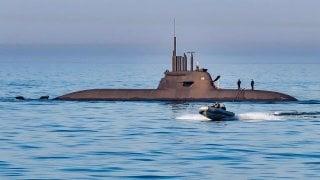Type 212CD: Germany and Norway Have Big Plans for a New Submarine
Six Type 212CD submarines have been ordered – with four slotted for delivery with the Royal Norwegian Navy (the first in 2029) and two slotted for the German Navy (with delivery in 2031 and 2034).
The Germans and the Norwegians are working together to develop a new submarine, the Thyssenkrupp Marine Systems (TKMS) Type 212 common design (CD). Perhaps motivating the German/Norwegian submarine design and development: an increasingly assertive Russia. Or perhaps, Donald Trump’s insistence that NATO’s European member states pay their fair share of Europe’s defense burden. Regardless, construction on the first Type 212CD has already begun. Six Type 212CD submarines have been ordered – with four slotted for delivery with the Royal Norwegian Navy (the first in 2029) and two slotted for the German Navy (with delivery in 2031 and 2034).
Working Together on Type 212CD Submarine
According to Naval Technology, “The German and Norwegian Governments signed an agreement for the joint development, procurement, operation and maintenance of the submarines in June 2017. The cooperation also extends to naval missiles, strengthening the cooperation between the navies as well as expanding industrial, research and development cooperation.”
In Kiel, Germany, a German-Norwegian Building Program Office (BPO) will be established. The BPO s expected to represent both Germany and Norway with respect to design and construction decisions. Management will alternate between German individuals and Norwegian individuals, while one-third of the staff will be Norwegian.
Similarly, after the program is up and running, a Lifetime Management Program Office (LMPO) will be established at Haakonsvern Naval Base in Norway, where one-third of the staff will be German. The LMPO will handle maintenance and repairs of the new submarines.
The development of the six Type 212CD submarines is expected to require about $6.4 billion.
The new submarines will be based upon the preceding Type 212A class submarines, although, the CD-variant will have some key differences.
“The new Type 212CD submarines will feature unique structure, modern combat systems, huge firepower and superior stealth technology,” Naval Technology reported. Most notably, the CD-variant will be about twice the size of the A-variant. Also the Type 212CD will feature a new stealthier diamond-shaped hull, which should deflect active sonar emissions.
Like the 212A, the CD-variant will be rigged with a hydrogen fuel cell-based air-independent propulsion system. “The HDW fuel cell system offers a unique solution for non-nuclear submarine integration,” Naval Technology reported. “It is specially developed as a silent energy converter and extension to a conventional propulsion system.”
Although, whereas the 212A had just one diesel engine, the 212CD will have two – which should improve endurance on the CD-variant relative to the A-variant.
“The submarine’s unique diamond shape design will ensure significant target echo strength (TES) reduction, while fuel cell-based air-independent propulsion will allow it to stay submerged for several weeks with no extra signature,” Naval Technology reported. “Furthermore, the unique non-magnetic architecture makes the vessel undetectable to future magnetic anomaly detection (MAD) sensors.”
The 212CD will feature a new combat system, known as ORCCA, which Naval Technology rated as “the most advanced combat system for non-nuclear submarines available on the market.” TKMS’s naval electronics division, Atlas Elektronik, will develop ORCCA in collaboration with Norway’s Kongsberg.
The ORCCA system should be able to process large amounts of sensor data, granting the 212CD operators enhanced situational awareness and enhanced interoperability with allied forces.
Indeed – “the system allows its operator to undertake an integrated data analysis from a range of onboard systems through a single multipurpose interface for sound and rapid decision-making.”
Outfitting the Type 212CD
The Type 212CD will feature naval strike missile (NSM) type anti-ship guided missiles. The NSM Block 1A missile has proven effective when targeting either marine-based, or land-based, targets.
The NSM is a fifth-generation, long-range precision attack missile that relied upon an inertial navigation system, military GPS received, and laser altimeter to strike with precision accuracy.
“The NSM’s stealthy design, along with the unique passive infrared and imaging sensors, make it extremely difficult to detect while increasing accuracy and reducing collateral damage,” Naval Technology reported.
The submarine will also, of course, feature four submarine tubes. Specifically, four 533mm DM2A4 IDAS torpedo tubes, which will give the Type 212CD the ability to target fellow submarines or ships.
The Type 212CD will also feature two optronics masts, which will feature the Hensoldt OMS 150 and OMS 300 sensors. The Hensoldt models will be used in favor of the hull-penetrating periscope used on the Type 212A.
Additionally, a Hensoldt panoramic surveillance system will be installed. Similarly, Kongsberg will install the active SA9510S MKII Mine Avoidance and Navigation Sonar.
The finished Type 212CD is to be 239 feet long with a 32 foot beam and a 23 foot draught. The submarine will displace 2,500 tons when surfaced. Using the air-independent propulsion system and the two MTU diesel engines, the Type 212CD will be able to achieve top speeds of about 20 knots.
About the Author
Harrison Kass is a defense writer and expert with over 1,000 articles published. An attorney, pilot, guitarist, and minor pro hockey player, Harrison joined the US Air Force as a Pilot Trainee but was medically discharged. Harrison holds a BA from Lake Forest College, a JD from the University of Oregon, and an MA from New York University. Harrison listens to Dokken.


